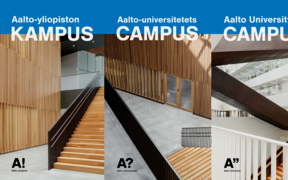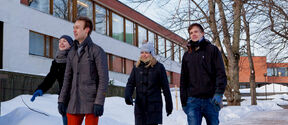Architectural gems of Otaniemi

If Otaniemi was superimposed over central Helsinki, it would cover the area from Hakaniemi to Ruoholahti. And owing to its super-size, Otaniemi is home to a wide variety of urban environments, districts, and buildings. A large part of Otaniemi has traditionally been the stronghold of Finnish technical education and research, but now a multidisciplinary and diverse Otaniemi is being built for all to enjoy.
Originally the preserve of rural villages and manor houses, Otaniemi is a special place in which to study and work. The campus brings together some of the finest examples of traditional and contemporary Finnish architecture.
Hopefully, the well-known campus buildings, workshops, creative events, business community, lush greenery, and vibrant student life of today’s Otaniemi will be as fondly remembered in decades to come by present students as was the case for the so-called ‘teekkarit’ generation of technology students gone by.
Aalto University began operations in 2010, with the merging of the Helsinki School of Economics, the School of Art and Design, and the Helsinki University of Technology. The new university took its name from perhaps the most internationally renowned and respected Finnish architect, Alvar Aalto, who was also a designer and entrepreneur.
‘He is probably still better known than Aalto University itself’, surmises Antti Ahlava, Vice President for campus development.
When the decision was taken to base Aalto University’s main campus in Otaniemi, everyone knew there was a lot of building work ahead.

Aalto University’s Undergraduate Centre, occupying the site of the main building of the former Helsinki University of Technology, is one of Otaniemi’s prime landmarks. The landscape-dominating stature of the new building is equal to that of its predecessor. In fact, with its surrounding terraced banquet courtyards, the building’s auditorium is reminiscent of ancient Greece. The listed building was restored by Aalto University in 2015.
The heart of Aalto University’s campus area is constructed in line with Alvar Aalto’s land use plan. The well-known buildings now called the Undergraduate Centre (the former main building of Helsinki University of Technology) and the Harald Herlin Learning Centre (formerly the library of Helsinki University of Technology) both represent some of Alvar Aalto’s most important architectural works. Other architectural gems found on the Otaniemi campus include the Shopping centre designed by Aalto, Reima and Raili Pietilä’s Dipoli, and the Otaniemi chapel designed by Heikki and Kaija Sirén.
Otaniemi has been designated as a nationally significant cultural environment by the National Board of Antiquities. The Undergraduate Centre,
Otaniemi chapel, and Dipoli are all protected by DOCOMOMO (International Committee for Documentation and Conservation of Buildings, Sites and Neighbourhoods of the Modern Movement).
A modern campus of many summits
Following his architecture competition win at the end of the 1940s, Alvar Aalto was commissioned to design the Otaniemi site as the Helsinki University of Technology prepared for its move from Hietalahti, Helsinki. Aalto chose to position several buildings in ways that complimented the site’s many hills, setting aside the lowland areas for grass fields and car parks.
In fact, there wasn’t much by way of forestry in the area at this time, with arable and pasture land previously dominating the site. Otaniemi has a rich history of manor houses dating back to the 16th century. Indeed, alongside many of the area’s more traditionally well-known features, the Hagalund manor courtyard, located behind the School of Chemical Engineering’s main building, often goes unnoticed. The site of the current Undergraduate Centre was previously occupied by the Otaniemi manor house, once owned by the von Wright family.
Alvar Aalto left the manor house's original lime avenues in his plans for the Otaniemi campus. Prior to his success in the state-sponsored architectural competition for the Otaniemi site, Aalto had been a visiting professor at MIT, Cambridge, Massachusetts. In fact, the time he spent on American campuses can clearly be seen to have influenced his plans for Otaniemi.
‘Alvar Aalto perhaps envisioned Otaniemi as a mixture of MIT and Harvard University’s campus gardens, but in a slightly more modern and wild or rugged way that suited the landscape’, Antti Ahlava observes.
The origins of the red brick architectural style found in both the former Helsinki University of Technology’s main building and the first student residences are not, in fact, industrial in nature; rather the use of the bricks stems from Alvar Aalto’s so-called ‘red brick period’. In the early days of Otaniemi’s re-development, the decision to use red bricks was dictated both by chance and practical reasons.
On the first night of heavy bombing in Helsinki during the Continuation War, the Soviet Embassy was itself badly damaged. The Finnish government donated the red bricks from the collapsed building to the technology students of the time. Once they had been cleaned, the bricks were first put to use in the construction of the student residences designed by Heikki Sirén and Martti Melakari.
The belief that Otaniemi is entirely covered by red brick buildings is not entirely true. Not even all of the buildings designed by Aalto himself are red bricked. For example, the Otahalli sports complex, situated at Otaranta 6 and completed for the Helsinki Olympics, and the Shopping Centre completed in 1960 are both rendered with plaster.

Typical to the Nordic tradition of nature-based modernism, the glass south wall of the building allows light to burst through from beneath the narrow roof slats. Situated in nature itself, the altar lies at the head of the building, on the other side of the window.
Multi-faceted architectural excellence
In Antti Ahlava’s opinion, the significance of Alvar Aalto’s status as an architectural heavyweight in his own time cannot be emphasised enough.
‘In addition to the ways be made advances in physical architecture, Aalto also realised a new, more humanistic, organic, and everyday style.’
‘Otaniemi was designed and built using the limited resources and materials available after the war. And, yet, he still managed to make a horizon-dominating entity, replete with inventive indoor spaces.’ The Undergraduate Centre and the Harald Herlin Learning Centre constitute an architectural whole.
Aalto also designed a residential building for Otaniemi. The dynamically modelled student dormitory from 1966 can be found at the Jämeräntaival 1 street address.
While taking a tour of Otaniemi’s architectural sights, one can also admire Aalto’s Saha building, completed in 1954 at the Konemiehentie 1 street address. Today, the building is home to Aalto University’s School of Business’ students’ banquet hall.
The materials used in the winding stairways and wooden roof structures of Alvar Aalto’s Otahalli sport complex, completed for the 1952 Olympics, represent Aalto’s elegant functionalism.
For any fans of industrial architecture or the so-called ‘steampunk’ style of modern architecture, the towering glass façade of the heat distribution plant designed by Aalto, which can be found at the Otakaari 6 street address, is a must-see. The foundations of the building lie 6.5 kilometres deep in bedrock, which is being drilled as part of the St1 Deep Heat pilot project. The project is seeking to realise Finland’s first industrial-scale geothermal energy plant.
Many new buildings have been built on the campus site over the years, although some progress is made at a more sedentary pace. It is fascinating to see how the new generation of architects have tipped their hats to Alvar Aalto’s legacy.
One of the latest to put their own stamp on the Otaniemi site is Verstas Architects, who are responsible for the A Bloc shopping centre and facilities for two schools. This development consists of two coordinated spaces, connected by four parallel glass-ceilinged lightwells. The ambience of the indoor spaces changes according to the purpose of the space. The external façade grabs the attention of onlookers with its pale silk prints on the glasswork towards the top of the building, as well as with the School of Business’ glass gable end, which is somewhat reminiscent of a lantern.

The building currently known as Nanotalo, situated at Otaniemi’s Puumiehenkuja 2 address, was in large designed by Alvar Aalto and is one of the area’s architectural gems. Entering the building’s extremely well preserved lobby feels like stepping back in time to a wealthy seaside villa. Nowadays, the building is home to part of the Department of Applied Physics and two Academy of Finland centres of excellence run by Aalto University’s Low Temperature Laboratory.
Towards a human-centred urban environment
In addition to Alvar Aalto’s masterpiece, Otaniemi naturally boasts some less-frequented districts and buildings.
‘In contrast to today’s way of thinking, the urban planning that took place at the midpoint of the 20th century, emphasised cars and especially the distance between buildings, as well as the monumentalism of the architecture. When we asked people using the area what their hopes for the future of Otaniemi were, they wanted less referencing of the past and a less institutional feel and, instead, more variety and a pedestrian-friendly approach’, Antti Ahlava notes.
He too hopes that Alvar Aalto’s legacy empowers brave architectural creativity, true to contemporary ideals, rather than restricting the development of Otaniemi. ‘The university wants to continue to be an internationally significant architectural site.’

Dipoli, constructed using natural stone, concrete, copper, and wood is the crowning glory of architects Raili and Reima Pietilä and one of the most expressive and radical examples of Finnish architecture. More than anything else, Reima Pietilä envisioned Dipoli as a site for human interaction and as a continuously changing process, rather than a static space.
Among Dipoli’s main features are its seven sculptural fireplaces, its exceptionally multi-functional layout, the natural light that penetrates the spaces between the building’s thick framework, and its confoundingly modernist cavelife spaces with their angular plastic geometry, juxtaposed against the rationalised office area. Built with due reverence to its origins on the foundations of the former technology students’ residence, Aalto University’s Dipoli building is now protected thanks to the university’s efforts. Today, Dipoli functions as the university’s main building and as a meeting venue.
Welcoming and energised
It is estimated that by 2025 there will be three to four times as many people living and working in Otaniemi than in 2015.
The architectural style of the former Helsinki University of Technology very much represented the 1950s modernist fondness for urban planning around car transport and monumentalism, where home life, work, and public services were thought of separately. According to Antti Ahlava, the tenets of contemporary design are human-centredness, walkable environments, multifunctional outdoor spaces, and the blurring or merging of organisations. While nature on campus is set to be preserved, its vibrancy will only increase.
The more tightly-knit Otaniemi of today also has a new age-group to serve – the hundreds of school children who use the university’s buildings as part of its ‘School as a service’ operating model.
New apartments are being built in the Kivimies area on Otaniemi’s southern point. These will be joined by a Chemistry district in the vicinity of the Metro station, which will also include recreational space for students, funded separately through a project run by the university’s student organisations. Apartments are also being built alongside the Otakaari district, in Maari and Servinniemi.
The multifunctional spaces on the building’s ground floor will be open to everyone and home to innovative and welcoming workspaces, cafes, and restaurants.
The idea behind this plan is that students and employees will create the daytime buzz about the place, while the apartments’ new residents will continue this into the night. And thanks to its excellent transport connections, including the Metro and the upcoming Jokeri Light Rail line, Otaniemi is the ideal venue to organise events serving the whole Greater Helsinki region.
In Antti Ahlava’s estimation, Otaniemi has been a test case for ways to develop the suburban areas of the 1950s and 60s into more people-centred, multifunctional, and enjoyable spaces. ‘The same principles can be applied to developments in similar areas to ours. In fact, the successes we’ve had are being closely followed by other cities.’
Everyone visiting, living, and working in Otaniemi is currently bearing witness to the frenetic building work going on throughout the area. In the years to come, the Aalto Works district, home to innovation and start-up enterprises, the Aalto Studios media centre, and much more will all sit alongside the area’s new residential developments.
‘Some people seem to think that when the work on Väre and the School of Business is over, the development stops there. In actual fact this is just a small taste of what the future holds!’
Text: Dakota Lavento
Main image caption: The Harald Herlin Learning Centre, the former Helsinki University of Technology library, belongs to a series of important library designed by Alvar Aalto. When observing the fan-shaped building, one’s eye is drawn to the use of indirect light, staircases, and human scale. The renovation was awarded the Finlandia Prize for Architecture in the autumn of 2017.
This article was first published in Aalto University Campus journal in December 2018.
Aalto University campus journal
The campus development journal examines eg. what Otaniemi looks like in 2050, how to add more green to the campus as well as how a startup ecosystem works.

Read more news

Are you tired of bad news?
The Laboratory of Hope exhibition presents ideas for a brighter future from 5th February to 27th March 2026
Sensory-friendly relaxation room voted students’ top idea
The winner of the 2025 participatory budgeting vote was announced at the end of November.
Start the year with new insights – apply for FITech's spring courses!
Deepen your knowledge with courses from Finnish universities of technology, designed to meet the demands of the working life and help deepen your expertise for free.






